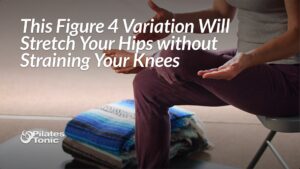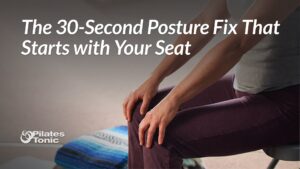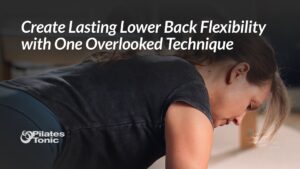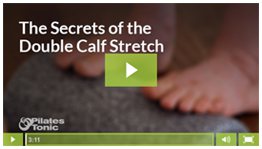A common cause of sacroiliac joint dysfunction is a lack of movement and one of the most powerful, yet overlooked tools for relieving back and SI (sacroiliac) joint pain is your breath. A common cause of sacroiliac joint dysfunction is a lack of movement. When you inhale and exhale, this innate action ideally sets off a series of events inside your body that mobilizes and nourishes your spine and keeps your back flexible.
In our culture, shallow breathing has become an all-too-common habit for many and is the real source of many types of common pains, including neck pain, back pain, headaches, anxiety, and SI joint pain, to name just a few.
A few years back, I posted a series of training videos demonstrating some of the best breathing exercises for fine-tuning larger movements of the body, for example, Pilates roll-downs and bridges, and this was how I focused the series. The exercises taught in this series also happen to be fantastic for relieving SI joint pain.
I could show you a hundred different stretches for your back and hips, but I can't reiterate enough how important it is for the health of your spine to learn and practice basic, foundational breathing. Learning how to breathe better is critical to basic spinal health.
The following two videos demonstrate the most powerful exercise I learned from Marie-José Blom for maintaining and regaining the health of your spine and SI joint.
This is my go-to exercise for folks who come into the studio with sacral and low-back pain.
It may seem subtle at first, but I encourage you to give it a try. And, if you’re currently experiencing SI discomfort and/or back pain, I really encourage you to try this exercise daily for the next two weeks and see what happens.
(Note that, in the first video, the actual exercise starts at around 2:35 so feel free to jump ahead.)
If you have any questions or feedback I’d love to hear from you in the comments below!
See you in the studio,
Sydney





15 Responses
Simple workouts. excercise for essential bone movements will help a lot in overcoming joint pains. Thanks for posting such informative article. Hope to see more.
Thanks for your feedback Williams!
I love your videos! I’m just discovering pilates so I really need the detail you offer. I am still in my lower back and your videos are helping me understand how to incorporate the abs to release the lower back….. I would suggest , however, that the fellow who does the demo wear a more fitted shirt and pants so I can see more clearly the moves his body is making when you are articulating the movement he is demonstrating. Keep them coming….
Great feedback Lynne, thank you!
Hi Sydney,
Your explanation of nutation/counternutation associated with the breathing in your first video confuses me. I’ve learnt the pelvic floor counternutate the sacrum while spinae erectors nutate it. Considering this, with a diaphragmatic breathing, I understand the sacrum should counternutate on the exhalation (due to the natural slight contraction of the pelvic floor). You describe the reverse. Could you shed light on this for me please? Thanks a lot!
Hi Lucie, Since the coccyx is embedded in the posterior pelvic floor, I could see how one might approach movement of the sacrum via the pelvic floor.
That said, the natural movement of the sacrum is driven by the diaphragm. It’s this movement many people are missing, which certainly could have something to do with a muscle/s around the sacrum.
Give the exercise in the first video a try and see how it feels to sense the sacral base moving posterior (counternutating) as you inhale,and the sacral base moving anteriorly(nutating) as you exhale.
The only effort you need for this, is that of your inhale and exhale, no any additional muscular contraction required. I’d love to hear how it goes! Thanks for your question.
You say the sacral base moves posterior on inhale. Is the base the bit with coccyx attached?
Thanks for your great question, Bill! The sacral base is the widest part of the sacrum, closer to the waistband, opposite end from where the coccyx attaches.
Thank you for your quick reply! I’ll try the exercice and have a look at the reference you mentionned. It’s a very interesting topic!
Hi! I broke my pelvis and pubic bones in 2 places each last Nov. At 70 years young it has been a slow healing process and a painful one too! Lately most of my pain has been located in my lower rib cage starting on the left side and then the right side joins in about 1-2 hours later. This becomes unbearable and at times I have to reach for the dreaded pain meds till I found YOU!! None of my dr’s quite get this and I have used my quota of PT for the pelvic and pubic pain. I want to THANK YOU SO MUCH for all your help with this and if you can think of any other of your videos that can help me please let me know. So far I am using the rib cage breathing and one side breathing, THANKS AGAIN! Lee
Hi Lee, Thank so much for sharing your feedback and I’m thrilled that the videos have been helpful! Without seeing you I’m unable to give specific advice, but breathing exercises in general are beneficial in many ways. Below I’ve linked to a few other breathing exercises you might find helpful:
https://pilatestonic.com/2013/understanding-your-core-connections-part-1/
https://pilatestonic.com/2012/mindful-breathing-for-health-posture-and-pilates/
https://pilatestonic.com/2015/interoception-your-fascia-shimmy-and-why-it-matters-so-much/
Wishing you all the best!
Hi Sydney, you say there are 3 videos in the intro ? I only see 2. What am i missing ?
Hey Denise! I didn’t include the third video on this particular post because it’s not part of the protocol for SI Joint relief. Here’s the link though in case you’d like to check it out:
https://pilatestonic.com/2014/how-to-initiate-a-roll-down-part-3-of-3/
Thanks for your question!
Hi Sydney,
I just want to say thank you for he things you explain on this page (including the replies in the comments). The breathing you mention definitely relieves pain in my sacral base. My sciatica even temporarily lessens in the inhalation part of my breathing which is quite interesting–possibly because the posterior position fixes my pelvis? Would you say some of these exercises that promote counter nutation can fix sacral torsion?
Thanks!
Hi Javier, Thanks for sharing, and I’m happy the information on this page has been helpful! I can’t say if the exercises will fix sacral torsion, but they won’t hurt anything and if you’re feeling some relief when you do them, that’s a great sign. The exercise in the video linked below might be helpful too.
https://pilatestonic.com/2021/use-your-breath-to-massage-low-back-tightness-away/